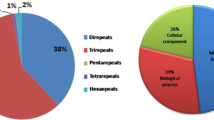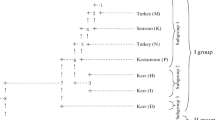Abstract
Horsegram [Macrotyloma uniflorum (Lam.) Verdc.] commonly known as kulthi or Madras gram is an important drought tolerant legume crop used as food and fodder in India and across the globe. Horsegram is tolerant to many biotic and abiotic stresses and considered a potential future food legume. Despite being a multiutility crop, insufficient genomic information is available in this species, which is otherwise required for genetic improvement. Hence, in the present work we used next-generation sequencing (NGS) technology for genome-wide development and characterization of novel simple sequence repeat (SSR) markers in horsegram. In all, 2458 SSR primer pairs were designed from NGS data and 117 SSRs were characterized in 48 diverse lines of horsegram. Cross-transferability of these markers was also checked in nine related legume species. The polymorphic SSRs revealed high diversity measures such as mean values of expected heterozygosity (He; 0.54), observed heterozygosity (Ho; 0.64), and polymorphism information content (PIC; 0.46). Analysis of molecular variance (AMOVA) revealed high degree of genetic variance within the populations. Dendrogram based on Jaccard’s similarity coefficient and principal component analysis (PCA) revealed two groups in the analyzed accessions. This observation was further confirmed by Bayesian genetic STRUCTURE analysis. The SSR markers developed herein can be used in diverse genetic analysis including association map** in this crop and also in related legume crops with limited marker resources. Hence, this new SSR dataset can be useful for molecular breeding research in this underutilized pulse crop. In addition, genetic diversity estimates of analyzed germplasm can be important for devising future breeding programmes in horsegram.



Similar content being viewed by others
References
Agarwal M, Shrivastava N, Padh H (2008) Advances in molecular marker techniques and their applications in plant. Sciences. Plant Cell Rep 27:617–631
Allen ON, Allen EK (1981) The Leguminosae: a source book of characteristics, uses, and nodulation. Univeristy of Wisconsin Press, Madison,WI, USA, p 446
Bhardwaj J, Chauhan R, Swarnkar MK, Chahota RK, Singh AK, Shankar R, Yadav SK (2013) Comprehensive transcriptomic study on horsegram (Macrotyloma uniflorum): de novo assembly, functional characterization and comparative analysis in relation to drought stress. BMC Genomics 14:647
Blumenthal MJ, Staples IB (1993) Origin, evaluation and use of Macrotyloma as forage-a review. Tropical Grassl 27:16–29
Botstein D, White RL, Skolnick M, Davis RW (1980) Construction of a genetic linkage map in man using restriction fragment length polymorphisms. Am J Human Genet 32(3):314–331
Chaitanya DAK, Kumar S, Reddy M, Mukherjee AM, Sumanth NSV, Ramesh DA (2010) Anti urolithiatic activity of Macrotyloma uniflorum seed extract on ethylene glycol induced urolithiasis in albino rats. J Innovative Trends Pharma Sci 1:216–226
Chung AM, Staub JE, Chen JF (2006) Molecular phylogeny of Cucumis species as revealed by consensus chloroplast SSR marker length and sequence variation. Genome 49:219–229
Divya Shikha (2015) Analysis of genetic diversity and population structure in horsegram (Macrotyloma uniflorum) germplasm using SSR markers. MSc Thesis, P 87. Department of Agricultural Biotechnology, CSK Himachal Pradesh Krishi Vishvavidyalaya, Palampur, India
Doyle JJ, Doyle JE (1990) Isolation of plant DNA from fresh tissue. Focus 12:13–15
Earl DA, VonHoldt BM (2012) STRUCTURE HARVESTER: a website and program for visualizing STRUCTURE output and implementing the Evanno method. Conserv Genet Resour 4(2):359–361
Evanno G, Regnaut S, Goudet J (2005) Detecting the number of clusters of individuals using the software STRUCTURE: a simulation study. Mol Ecol 14(8):2611–2620
Gopalan C, Ramashastri BV, Balasubramanyan SC (1989) Nutritive value of Indian foods. Hyderabad, India: National Institute of Nutrition, ICMR P 156
Gutierrez MV, VazPatto MC, Huguet T, Cubero JI, Moreno MT, Torres AM (2005) Cross-species amplification of Medicago truncatula microsatellites across three major pulse crops. Theor Appl Genet 110:1210–1217
Hamada HM, Petrino MG, Kakunaga T (1982) A novel repeated element with Z-DNA forming potential is widely found in evolutionarily diverse eukaryotic genomes. PNAS 79(21):6465–6469
He G, Woullard FE, Marong I, Guo BZ (2006) Transferability of soybean SSR markers in peanut (Arachis hypogaea L.) Peanut Sci 33:22–28
Jayaraj AP, Tovey FI, Lewin MR, Clark GC (2000) Duodenal ulcer prevalence: experimental evidence for possible role of dietary lipids. J Gastroenterol Hepatol 15:610–616
Kadam SS, Salunkhe DK, Maga JA (1985) Nutritional composition, processing, and utilization of horsegram and moth bean. Critical Rev Food Sci Nutri 22:1–26
Kalinowski ST, Taper ML, Marshell TC (2007) Revising how the computer program CERVUS accommodates genoty** error increases success in paternity assignment. Mol Ecol 16:1099–1106
Lackey JA (1981) Phaseoleae. In: advances in legume Systematics. (RM Polhil and PH raven, eds). Royal Botanic Gardens, Kew, UK, pp 301–327
Mehra A, Upadhyaya M (2013) Macrotyloma uniflorum Lam. Traditional crop of kumaun Himalaya and ethnobotanical perspectives. Int J Agril Food Sci 3(4):148–150
Morris JB (2008) Macrotyloma axillare And M. uniflorum: descriptor analysis, anthocyanin indexes, and potential uses. Genet Resour Crop Evol 55:5–8
Murthy SM, Devaraj V, Anitha RP, Tejavathi DH (2012) Studies on the activities of antioxidant enzymes under induced drought stress in vivo and in vitro plants of Macrotyloma uniflorum (lam.) Verdc. Recent Res Sci Tech 4:34–37
Neelam S, Kumar V, Natarajan S, Venkateshwaran K, Pandravada SR (2014) Evaluation and diversity observed in Horsegram (Macrotyloma uniflorum (lam) Verdc.) Germplasm from Andhra Pradesh, India. Int J Plant Res 4(1):17–22
Oram RN (1990) Register of Australian herbage plant cultivars. edition. Melbourne, Australia, The Common wealth Scientific and Industrial Research Organisation
Patel DP, Dabas BS, Sapraandal RS (1995) Evaluation of Horsegram (Macrotyloma uniflorum Lam.) germplasm. In: National Bureau of Plant Genetic Resources Publication, New Delhi, India
Peakall R, Smouse PE (2012) GenAlEx 6.5: genetic analysis in excel. Population genetic software for teaching and research-an update. Bioinformatics 28:2537–2539
Perrier X, Jacquemoud-Collet JP (2006) DARwin software. http://darwin.cirad.fr/ Darwin
Prakash BG, Guled MB, Bhosale AM (2008) Identification of suitable horsegram varieties for northern dry zone of karnataka. Karnataka J Agril Sci 21(3):343–345
Pritchard JK, Stephens M, Donnelly P (2000) Inference of population structure using multilocus genotype data. Genetics 155:945–959
Provan J, Powell W, Hollingsworth PM (2001) Chloroplast microsatellites: new tools for studies in plant ecology and evolution. Trends Ecol Evol 16:142–147
Rajendrakumar P, Biswal AK, Balachandran SM, Srinivasarao K, Sundaram RM (2007) Simple sequence repeats in organellar genomes of rice: frequency and distribution in genic and intergenic regions. Bioinformatics 23:1–4
Ramesh CK, Rehman A, Prabhakar BT, Vijay ABR, Aditya SJ (2011) Antioxidant potential in sprout vs. seeds of Vigina radiate and Macrotyloma uniflorum. J Appl Pharma Sci 1:99–103
Reddy MRK, Rathour R, Kumar N, Katoch P, Sharma TR (2010) Cross-genera legume SSR markers for analysis of genetic diversity in lens species. Plant Breed 129:514–518
Reddy PCO, Sairanganayakulu G, Thippeswamy M, Reddy PS, Reddy MK, Sudhakar C (2008) Identification of stress induced genes from the drought tolerant semi-arid legume crop horsegram (Macrotyloma uniflorum (lam.) Verdc.) through analysis of subtracted expressed sequence tags. Plant Sci 175:372–384
Sharma V, Rana M, Katoch M, Sharma PK, Ghani M, Rana JC, Sharma TR, Chahota RK (2015a) Development of SSR and ILP markers in horsegram (Macrotyloma uniflorum), their characterization, cross-transferability and relevance for map**. Mol Breed 35:102
Sharma V, Sharma TR, Rana JC, and Chahota RK. (2015b) Analysis of Genetic Diversity and Population Structure in Horsegram (Macrotyloma uniflorum) Using RAPD and ISSR. Agril Res: 1-10
Smartt J (1990) Grain legumes: evolution and genetic resources. Cambridge University Press, Cambridge, UK
Sodani SN, Paliwal RV, Jain LK. (2004) Phenotypic stability for seed yield in rain fed horsegram (Macrotyloma uniflorum). Proceedings of the National Symposium on Arid legumes for sustainable Agriculture and Trade; Jodhpur, Rajasthan, India: Central Arid Zone Research institute
Soranzo N, Provan J, Powell W (1999) An example of microsatellite length variation in the mitochondrial genome of conifers. Genome 42:158–161
Sosulski F, Young CG (1979) Field and functional properties of air classified protein and starch fraction from eight legume flours. J Am Oil Chem Soc 56:292–295
Tautz D (1989) Hypervariability of simple sequences as a general source for polymorphic DNA markers. Nucl Acids Res 17:6463–6471
Varshney RK, Graner A, Sorrells ME (2005) Genic microsatellite markers in plants: features and applications. Trends Biotech 23:48–55
Yeh FC, Boyle TJB (1997) Population genetic analysis of codominant and dominant markers and quantitative traits. Belgian J Bot 129:157
Zane L, Bargelloni L, Patarnello T (2002) Strategies for microsatellite isolation: a review. Mol Ecol 11:1–16
Acknowledgements
Authors gratefully acknowledge the Department of Biotechnology (DBT), Department of Science and Technology (DST), Government of India and Japanese Society for Promotion of Science (JSPS) for providing financial support to conduct this work.
Author information
Authors and Affiliations
Corresponding author
Electronic supplementary material
Supplementary Table 1
(DOC 28 kb)
Supplementary Table 2
(DOC 212 kb)
Supplementary Table 3
(DOC 2757 kb)
Supplementary Fig. 1
Polymorphism shown in amplification profiles of 48 horsegram genotypes generated by newly developed markers a) MUGSSR-530 b) MUGSSR-32 c) MUGSSR-546 and d) Cross-transferability of MUGSSR-542 in nine releated species namely- M. gharwalensis, Cicer arietinum, Vigna unguiculata, Lens culinaris, Vigna mungo, Pisum sativum, Trifolium pratense, Vigna umbelleta and Phaseolu vulgaris (DOC 79 kb)
Supplementary Fig. 2
Percentage of species-wise cross-transferability observed in nine selected related species (DOC 50 kb)
Rights and permissions
About this article
Cite this article
Kaldate, R., Rana, M., Sharma, V. et al. Development of genome-wide SSR markers in horsegram and their use for genetic diversity and cross-transferability analysis. Mol Breeding 37, 103 (2017). https://doi.org/10.1007/s11032-017-0701-1
Received:
Accepted:
Published:
DOI: https://doi.org/10.1007/s11032-017-0701-1




